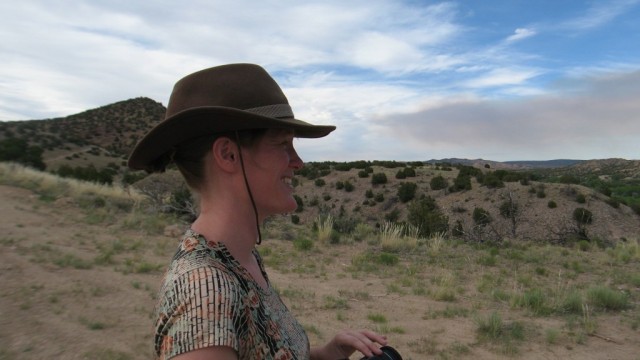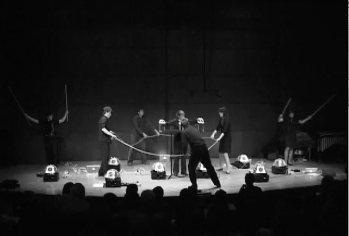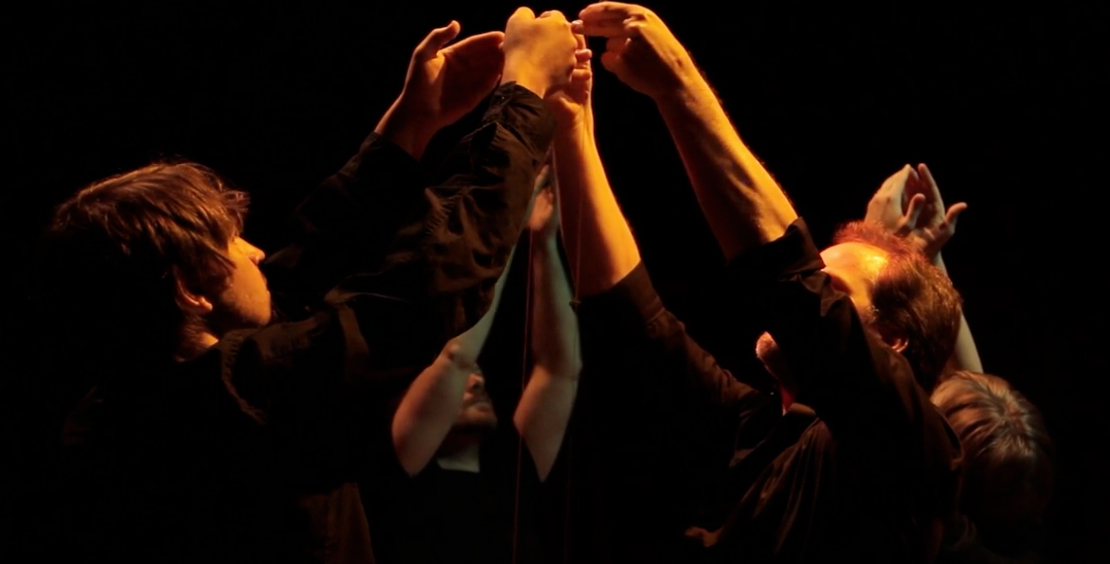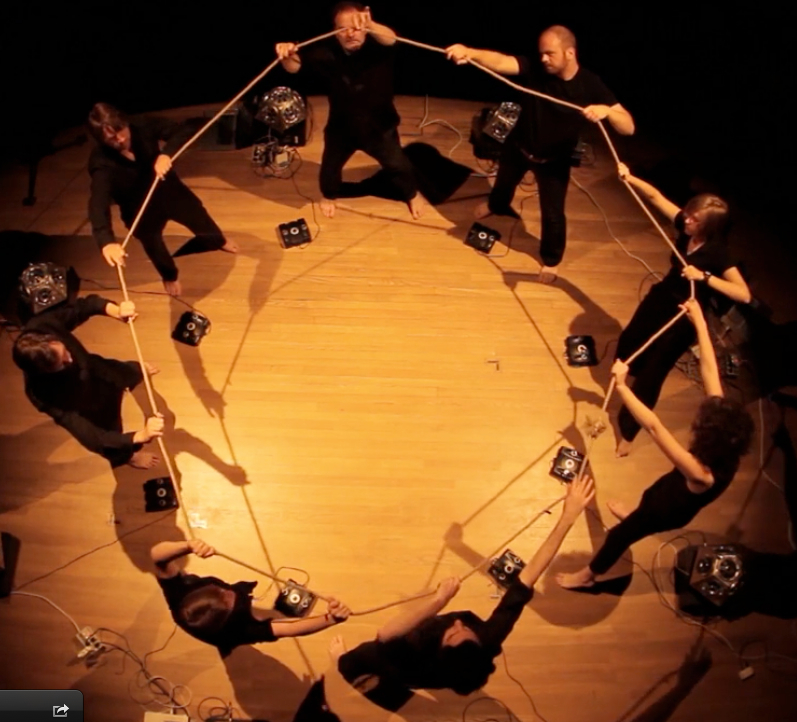
Anne Hege
From the Waters
About From the Waters
If laptop orchestras were used in ritual practice, what would that ritual be?
In 2009, inspired by Maya Deren’s description of Haitian Voudoun practices in her book Divine Horsemen: The Living Gods of Haiti, I began to imagine what the traditional practices Deren describes might look like accompanied by laptop orchestra. After three years of trial, error, and exploration, From the Waters was created.
First Generation
In 2010, I composed the first version of this work and titled it, Middle Passage: Reclaiming what is Lost. I was thinking about loss and the body and my grandfather who was buried at sea in World War II and the juxtaposition of the horror and loss of the Middle Passage and the connection of these realities to the belief in water and the sea as a holding space for the unclaimed spirit after death as described in the Voudoun practice Reclaiming from the Waters of the Abyss. This gradually transformed into thinking about a way to care for and connect with lost spirits which became the central theme of Middle Passage, a ritual concerto for laptop orchestra and the tape machine (shown below).
In this first version, I wanted to compose a musical multimedia work that was built from basic geometric forms – the circle and the line – drawn from the original Voudoun ritual. In Middle Passage, the circle is realized as a rope attached to eight evenly spaced out GameTrak tether controllers. Each of these controllers is connected to a computer that is connected to a six-channel hemispherical speaker (hemi). The ensemble plays the rope by collectively pulling it, triggering specific sounds based on rate and direction of movement. The circle is reinforced physically and sonically in the tape loop of the tape machine. To balance the circle, the line is present in the tether solo instruments (rear corners of the photo below). The GameTrak tether lines play through audio files using Dan Trueman’s dualvocoder application. Over the course of the piece, long rods are used to extend the tether strings and magnify the visual line in the physical space balancing the presence of the large rope circle. Finally, a radio transmitted ambient track, created from audio clips submitted by the ensemble players referencing someone they would like to remember, was spatialized throughout the hall by four ensemble members who carried hand held speakers. It was a wonderfully chaotic beginning (watch the premier performance here). As you can see below, the stage was crowded, but there is also a hint of the spirit being called. Can you see it in the circle to the left of the tape machine?
Second Generation
I was very happy with the first performance. I felt I had finally found my voice with the laptop orchestra: a piece where the computers weren’t in the way of people seeing, hearing and being with one another. Still, it was very clear that Middle Passage: Reclaiming What is Lost was a production that was too difficult and complicated to perform with any regularity. After some very helpful feedback and support from Dan Trueman, MR Daniel, Rinde Eckert, and members of PLOrk (Princeton Laptop Orchestra), I decided to revise the piece and see if I could distill it into something simpler and stronger. I was itching to do more with the rope and I wanted to add an introduction (a warm-up) that did not rely on singing. Rebecca Fiebrink’s application The Wekinator inspired my revision that became From the Waters (2012). With this new version, I wanted to create a work that could exist as a performance piece and a collective practice. I wanted From the Waters to be something a group could enjoy playing over and over as a practice, something that a group of strangers could learn and do together in an afternoon, as well as a piece that would engage an audience in a traditional concert setting. This is how it works…
The Setup
From the Waters has a flexible setup. I have performed it with three to eight computer/speaker stations (computer, GameTrak tether controller, and speakers also known as a PLOrk station). In PLOrk, they use a hemispherical six-channel speaker, but I have used stereo speakers for my own rope playing parties. The piece has been played by anywhere from five to forty participants. The PLOrk stations are setup in a circle. A thick rope (1-2” diameter), knotted into a circle big enough to fit as many players as you would like on the rope at once, is placed within the circle of PLOrk stations (see photo above).
Warm-up
The performance version is constructed in binary form. The A section is a warm-up and is meant to bring the participant’s attention to the present moment. Each player is paired with a partner and does a series of movements that are mirrored by the partner. The partner then trades places with the first player, so that everyone has a chance to play the warm-up and be mirrored. The movements and sounds triggered by holding the tether strings and moving are designed to help the participant focus their listening on their body, movement, and the movements of their partner as well as the other participants.
The sounds are composed to help guide the player to listen, see, and sense the unison of movement and sound. The sounds are designed in spherical layers (see diagram below), so that parameter 0 is the root tone (a vocal hum). Like nesting dolls, three layers of sound surround the root tone. The three dimensional sphere directly surrounding the root tone is the root tone frequency with 5 harmonics, the sphere around this is the root tone frequency with 8 harmonics, and the final sphere is divided in half where the upper half triggers the root tone frequency with 20 bubbling harmonics, and the lower half of the sphere triggers the root tone frequency transposed an octave with 10 harmonics.
This kind of spherical mapping would be impossible without the Wekinator application which allows a composer to “train” the computer. Using the Wekinator, I was able to map each 3-D, spherical area by training the computer to play certain sounds for certain physical areas that I would “color in” while the wekinator was in the training mode. Instead of attempting to discretely name each location, I was able to record examples of spaces for each sphere and thus suggest the sound I wanted in each general sphere. From there, the wekinator filled in the blanks – a very powerful program! The tether placements were trained based on choreographed full body movements that were derived from a dance/yoga vocabulary. In the workshop and conference practices, I repeat the A section until everyone has had a chance on a tether and there is a feeling of awareness and listening throughout the group of participants. In the performance context, the warm-up consists of the same movement series performed as four solos that then play as a quartet. The tethers are then passed to each person’s partner and they also play through the series so that everyone has played through at least once.
The Rope
When the warm-up is complete, the B section begins. In this section, one tether string from each controller is attached to a single, shared rope and on cue, the ensemble lifts the rope together. The tethers are programmed to trigger certain long tones when the rope is pulled in a certain direction at a certain rate. My hope is that this sound and motion mimics the beauty of the coordination of sound and movement when one bows a string. Other sounds are layered on top, triggered by the location of the tether using the Wekinator application. The ensemble, like playing a ouija board, can collectively control the sounds being played. For example, if the ensemble is still or slow enough, the long drones stop and the ensemble can search for new sounds within the Wekinator triggered tones. Rather than composing a linear composition where I tell people what and how to play, I think of From the Waters as an environment that people can collectively explore and create their ensemble “song.” It is my hope that they are guided to listen as Pauline Oliveros describes listening – in a whole way, including sound, movement, touch, emotion, memory, experience, and all that each player brings to the rope.
If you would like to read more about my process with this piece and why I think Laptop Orchestras are a vital part of contemporary culture see my article presented at the first Symposium of Laptop Ensembles and Orchestras (SLEO) and also the conclusion to my dissertation, Spirit in the Flesh (2014).
The Future
Since 2012, From the Waters has been used as a workshop on grief and connection, at conferences, group gatherings with musicians and dancers, and has also been performed in concert settings by the Princeton Laptop Orchestra and Sideband. This past January I led two workshops using the piece and was inspired to start working on a third version, From the Waters 3.0, that will focus on connection.
Deep down, I want to share the experience of playing this piece with others. I dream of building a rope that holds up to 100 people for outdoor playing as well as installing the piece in a gallery for pickup playing. If you want to help make these dreams happen or if you would like to come to a workshop please contact me through my website. If you would like to play the piece on your own or just the warm-up, feel free to download the software and directions here and please tell me about it. Finally, if you would like me to come lead the piece with your ensemble, I would love to! Please contact me. Let’s see where this goes…






Anne, this is great. I have loved the music, for a word oriented person this is most interesting to read. It really describes your creative focus very well. Blessings.
Thank you for reading and watching!
Interesting concept-love to experience this work.
Let’s find a way to have you play it!